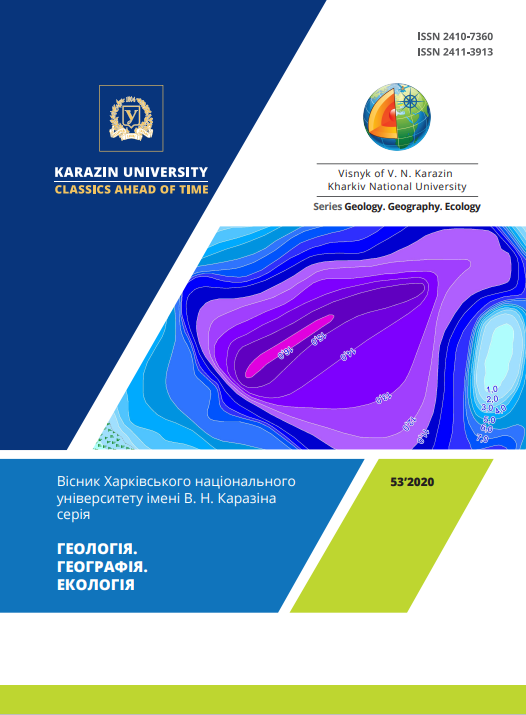Використання прогностичних моделей для короткострокового прогнозу граду на півдні України
Анотація
Град є одним з основних джерел збитків житловим, комерційним і сільськогосподарським активам в Україні. Вивчення умов виникнення крупного граду, особливо не передбачених стандартними методами прогнозу випадків зі значним матеріальним збитком, має завжди високу актуальність. Підвищення справджуваності та завчасності штормових попереджень про випадіння граду є важливою проблемою оперативного метеорологічного забезпечення. Складність її вирішення обумовлена недостатньою точністю модельного прогнозування метеорологічних параметрів атмосфери, неточністю визначення часу і місця виникнення конвективних явищ, рідкісної мережею спостережень і відсутністю, внаслідок цього, бази даних небезпечних явищ. У статті проаналізовані умови виникнення двох випадків градобою на території півдня України в 2017-2018 рр. У першому епізоді синоптики не прогнозували град, в іншому спостерігалося випадання надзвичайного граду (D = 65 мм). Визначені синоптичні і термодинамічні умови виникнення граду. Оцінені можливості застосування різних індексів нестійкості атмосфери, а також використання прогностичних даних чисельного моделювання глибокої конвекції (модель Global Forecast System - GFS) з кроком сітки 0,25о×0,25о. Виявлені найбільш інформативні параметри формування граду - Severe Weather ThrEAT індекс (скорочено SWEAT), Convective Available Potential Energy (скорочено САРЕ), Li (Lifted Index), BRN (Bulk Richardson Number) та ВІ (Boyden І). Наведені рекомендації щодо покращення якості короткочасного прогнозу граду з врахуванням даних чисельного моделювання.
Завантаження
Посилання
Ashabokov B.A., Fedchenko L.M., Tapaskhanov V. O., Shapovalov A.V. et al. (2013). Fizika gradovykh oblakov i aktivnykh vozdeystviy na nikh: sostoyaniye i napravleniya razvitiya [Physics of hail clouds and active impact on them: state and directions of development]. Nal'chik: OOO «Pechatnyy dvor», 216.
Buykov M.V., Kuz'menko A.G. (1978). O roste grada v superyacheykovykh gradovykh oblakakh [On the growth of hail in supercell hail clouds]. Meteorologiya i gidrologiya, 11, 6-15.
Bykov A.V., Vetrov A.L., Kalinin N.A. (2017). Prognoz opasnykh konvektivnykh yavleniy v Permskom kraye s ispol'zovaniyem global'nykh prognosticheskikh modeley [Forecast of dangerous severe convective storm in the Perm Territory using global predictive models]. Trudy Gidromettsentra Rossii, 363, 101-119.
Hrushevsʹkyy O.M., Mishchenko N.M., Mansarliysʹkyy V.F., Burtsev V.M. (2018). Pro mozhlyvosti diahnozu i prohno-zu hlybokoyi konvektsiyi v operatyvniy diyalʹnosti [On the opportunities of diagnosis and forecast of deep convec-tion during operational activity]. Ukrayinsʹkyy hidrometeorolohichnyy zhurnal, 22, 5-15.
Danov Ye.I., Danova T.Ye. (2001). K analizu superyacheykovogo gradovogo shtorma v Prichernomor'ye [On the analysis of a supercellular hail storm in the Black Sea region]. Meteorologiya, klimatologiya i gidrologiya: Mezh-vedomstvennyy nauchnyy sbornik Ukrainy, 44, 61-66.
Rukovodstvo k prognozu opasnykh osadkov, grada i shkvalov po dannym meteorologicheskikh radiolokatorov i iskusstvennykh sputnikov Zemli [Guide to forecasting hazardous precipitation, hail and squalls based on data from weather radars and satellites] (1996). SPb.: Gidrometeoizdat.
Sulakvelidze G.K. (1968). Livnevyye osadki i grad [Heavy rainfall and hail]. L., Gidrometeoizdat, 412.
Stykhiyni meteorolohichni yavyshcha na terytoriyi Ukrayiny za ostannye dvadtsyatyrichchya (1986-2005rr.) [Natu-ral meteorological phenomena on the territory of Ukraine for the last twenty years (1986-2005)] (2006). Za redaktsiyeyu V.M. Lipinsʹkoho, V.I. Osadchoho, V.M. Babichenko. Ukrayinsʹkyy naukovo-doslidnyy hidrometeorolo-hichnyy instytut. Derzhavna hidrometeorolohichna sluzhba. Kyyiv, Nika-Tsentr, 312.
Tolmacheva N.I., Yermakova L.N. (2011). Issledovaniye parametrov oblachnosti i yavleniy po dannym sputnikovogo i radiolokatsionnogo zondirovaniya [Research of cloudiness parameters and phenomena according to satellite and radar sounding data]. Geograficheskiy vestnik, 3.
Findayzen V, Shul'ts G. (1951). Eksperimental'nyye issledovaniya obrazovaniya ledyanykh chastits. Fizika obra-zovaniya osadkov [Experimental studies of the ice particles formation; Physics of precipitation], M., 312.
Shmeter S. M. (1987). Termodinamika i fizika konvektivnykh oblakov [Thermodynamics and physics of convective clouds]. L., Gidrometeoizdat, 287.
Andersson T., Andersson M., Jacobsson C., Nilsson, S. (1969). Thermodynamic indices for forecasting thunderstorms in southern Sweden, Meteorol. Mag., 116, 141-146.
Bedka K.M. (2011). Overshooting cloud top detections using MSG SEVIRI infrared brightness temperatures and their relationship to severe weather over EuropeAtmos Res., 99(2), 175–189. https://doi.org/10.1016/j.atmosres.2010.10.001
Browning K.A. (1975). Airflow and hail growth in super-cell storms and some implications for hail suppression. Nation. Hail Research Exper., 75/1.
Bunkers M.J. et al. (2000). Predicting supercell motion using a new hodograph technique. Weather and Forecasting, 15, 61-79.
Craven J.P. and H.E. Brooks (2004). Baseline climatology of sounding derived parameters associated with deep, moist convection. Natl. Wea. Dig., 28, 12–24.
Doswel C.A., Schultz D.M. (2006). On the use of indices and parameters in forecasting severe storm. Electron. J. Sev. Storms Meteorol., 1, 1-14.
Dworak R., Bedka K.M., Brunner J., Feltz W. (2012). Comparison between GOES-12 overshooting-top detections, WSR-88D radar reflectivity, and severe storm reports. Weather Forecast, 27(3), 684–699. https://doi.org/10.1175/WAF-D-11-00070.1
Fawbush E.F., and R.C. Miller (1953). A method for forecasting hailstone size at the earth’s surface. Bull. Amer. Meteor. Soc., 34, 235–244.
Kahraman A., Tilev-Tanriover S., Schultz Severe D.M. (2016). Hail Climatology of Turkey. Monthly Weather Re-view, 144(1), 337-346 https://doi.org/10.1175/MWR-D-15-0337.1
Mossop S.C. (1982). The origin and concentration of ice crystals in clouds. Bull. Amer. Soc., 66, 264-273.
Punge H. J., Bedka K. M., Kunz M., Werner A. (2014). A new physically based stochastic event catalog for hail in Europe. Springer. https://doi.org/10.1007/s11069-014-1161-0
Tuovinen J, Punkka A, Rauhala J, Hohti H, Schultz D.M. (2009). Climatology of severe hail in Finland: 1930–2006. Mon Weather Rev 137(7), 2238–2249. https://doi.org/10.1175/2008MWR2707.1
Vasques T. (2017). Instability, Skew-T & Hodograf. Handbook. Vasques T., USA.
Webb R., King P. (2009). Forecasting thunderstorms and severe thunderstorms using computer models. NSW Office. Commonwealth Bureau of Meteorology. Sydney. NSW. Australia, 67-76.
Webb J, Elsom D, Reynolds D (2001). Climatology of severe hailstorms in Great Britain. Atmos Res 56(14), 291–308. https://doi.org/10.1016/S0169-8095(00)00081-8
Zhang C, Zhang Q, Wang Y (2008). Climatology of hail in China: 1961–2005. J Appl Meteorol Climatol 47(3), 795–804.
Convective Season Environmental Parameters and Indices Available at: http://wx.awcolley.com/Meteorology/ConvParmsIndices#LIFTED
Wetterzentrale Top Karten Available at:https://www.wetterzentrale.de/reanalysis.php?map
European Severe Weather Database: Available at: http://www.eswd.eu/cgi-bin/eswd.cgi?&lang=en_0





